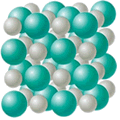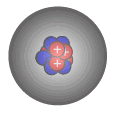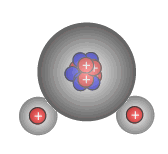|
The ratio of masses of elements within a chemical compound is always the same regardless of its source. There are, it seems, 'rules' regarding chemical composition. |
 |
Analysis of the constituent elements of compounds can be carried out in a variety of ways.
 |
In the late eighteenth century, Proust analysed different sources of several compounds. He found that they always contained the same ratio by weight of their elements. Table salt, for example, always contained 3.5 times as much chlorine as sodium. He also found that water always contained eight times as much oxygen as hydrogen. Finally, he found that the mineral known as cinnabar always contained 6.25 times as much mercury as sulfur. |
These results lead Proust to propose the law of constant composition, which states that, "the ratio of elements within any compound is always the same regardless of its source".
Historically, many experiments of this kind were performed and the results compared. It became apparent that the relative ratios of elements within compounds doesn't vary even if the compound is obtained from a variety of sources. Proust's law became universally accepted.
In simple terms, water will always contain hydrogen and oxygen in a mass ratio of 2 parts to 16 parts. It will have an atom ratio of 2 atoms of hydrogen for every atom of oxygen and have the formula H2O, no-matter how it is made, or where it is obtained from.
|
|
||||
|
solid water (ice)
|
Liquid water
|
gaseous water (steam)
|
These facts allowed a series of rules to be developed regarding the quantity of each element that could combine with another. The rules governing the number of atoms that each type of atom can combine with are called the valency rules. The concept of valency is covered in section 3.22.
The ratio of element mass within a compound depends on both the relative masses of the atoms involved as well as the number of them present. The ratio of atoms in water is 2:1, hydrogen to oxygen respectively.
 |
 |
 |
|
hydrogen atom: mass=1
|
oxygen atom: mass=16
|
water molecule: mass=18
|
However, as the mass of a hydrogen atom is 1 and the mass of an oxygen atom is 16, then the ratio in terms of mass is:
|
mass of 2 atoms of hydrogen = 2 x 1 = 2
to mass of 1 atom of oxygen = 1 x 16 = 16
The mass ratio of hydrogen to oxygen in water is always, 2 : 16 |
|
Example: Calculate the composition by mass of ethane C2H6 Ethane contains two carbon atoms with relative masses of 12 Therefore mass of carbon = 12 x 2 = 24 Ethane contains six hydrogen atoms with relative masses of 1 Therefore mass of hydrogen = 6 x 1 = 6 The mass ratio carbon to hydrogen is 24 to 6 Mass ratio = 4:1 |

